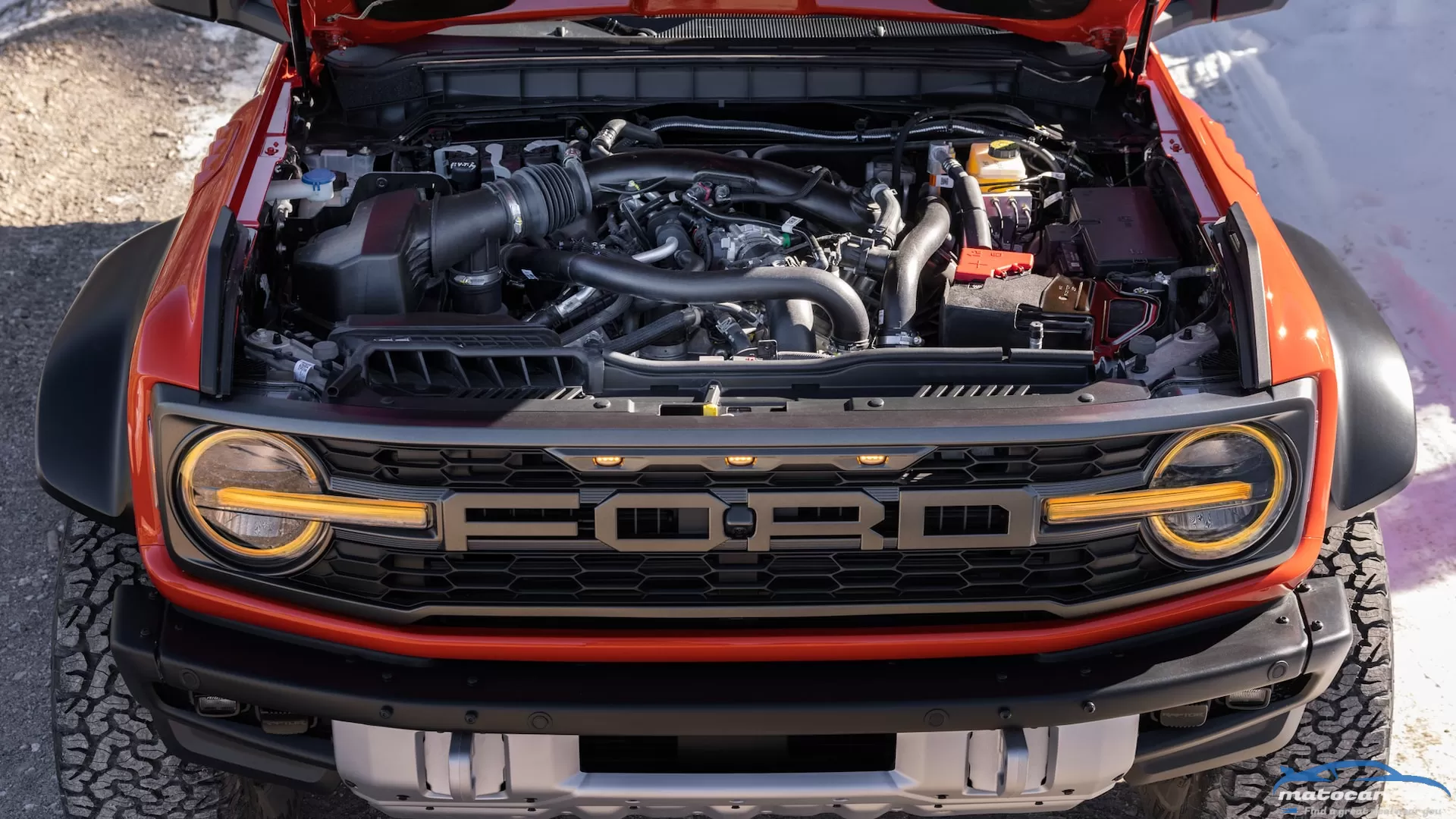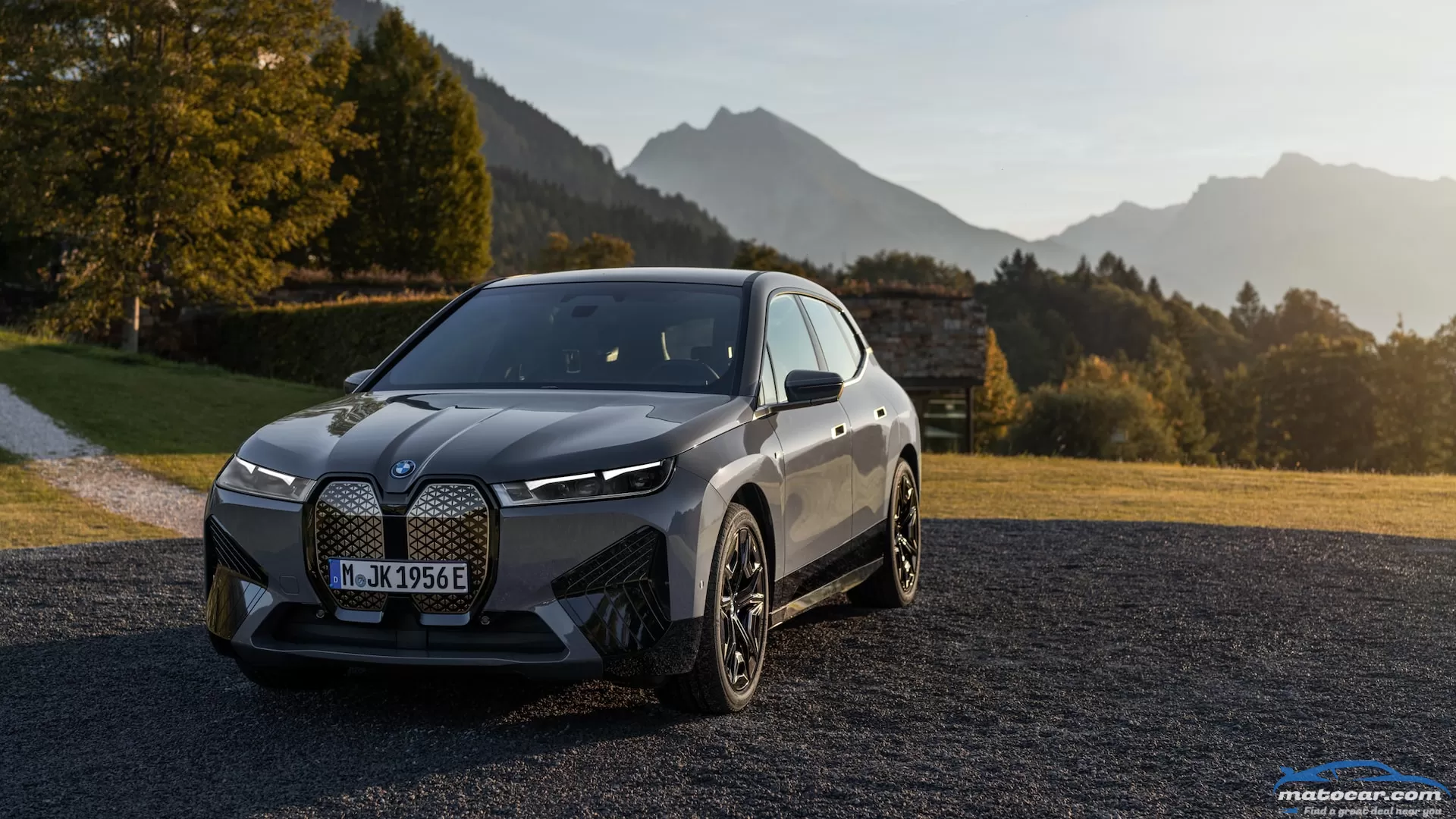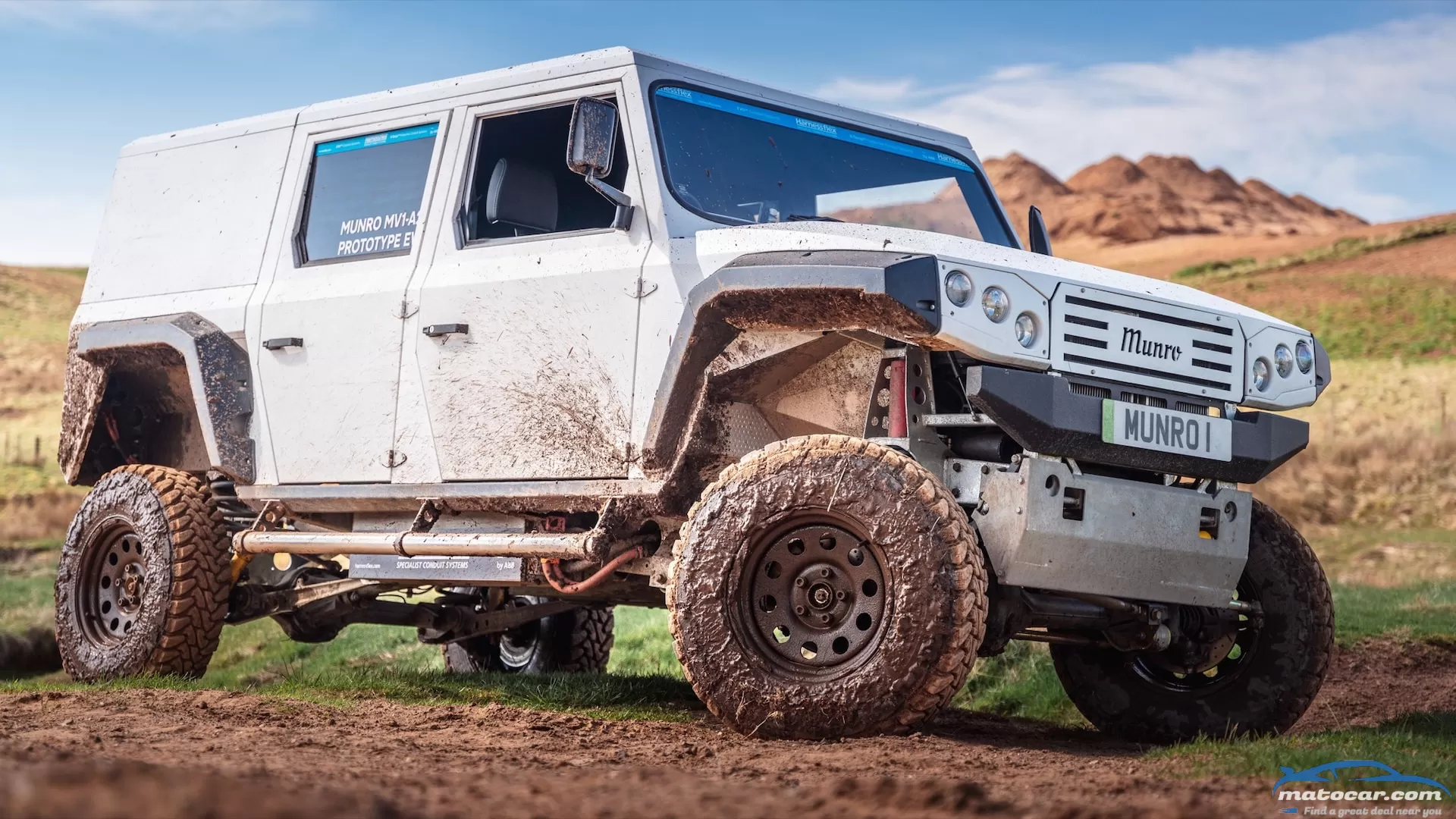How Ford Upgraded a Family SUV Engine for Bronco Raptor Duty

We've all known a Ford Bronco Raptor was coming, but nobody in the public Broncosphere has known for sure how Ford Performance planned to endow the Bronco with F-150 Raptor-worthy performance—would it do so using an EcoBoost V-6 (and if so, which one?) or a Coyote V-8? Well, now we know: The Ford Performance gang has worked its magic on the 3.0-liter EcoBoost twin-turbo V-6 from the Explorer ST, modifying it extensively to suit the Bronco Raptor's mission, which is to "reward the revs." (For more on the V-6/V-8 decision, head here.)
That means the engine should produce meaningful power all the way out to the far reaches of the tachometer while the standard 10-speed automatic transmission's gearing ensures that power is easy to explore the top of the tach. Here's what it took to turn a family SUV motor into a desert stormer for a hardcore 4x4, plus the modifications needed to get that power safely routed to the ground.
What's Under the Bronco Raptor's Hood?
You'll recall that the 3.0-liter EcoBoost is basically a bored and stroked EcoBoost Nano family sibling of the compacted-graphite-iron-block 2.7-liter powering other Broncos, so it bolts in with relative ease. Relative to the Explorer application, this Bronco Raptor 3.0 features unique cylinder heads that eliminate the exhaust-gas recirculation and emphasize maximum air flow into and out of the engine.
A giant high-flow intake airbox and filter drop air straight down into the turbos on each side, helping to reduce the overall restriction on the low-pressure side by 50 percent. The turbos themselves are new for the Raptor, and the plumbing to, from, and through the intercooler is improved to lower restriction. The combustion chambers flow more air, then aft of the turbos there is a full true dual exhaust system with 2.7-inch pipes and a new-to-Bronco four-position active-valve (Quiet, Normal, Sport, and Baja) that reportedly helps deliver a total drop in backpressure of 20 percent.
The combined effect of all these mods is greater "boost durability," which means the boost sustains to enhance high-end power and prevents that feeling of power falling off a cliff as you near the engine redline. The new Baja drive mode also activates an anti-lag turbo calibration that further maximizes performance during high-speed desert running. As of press time, the team is still six weeks or so from finalizing the engine's state of tune and certifying it with the EPA, but we're assured it will make north of 400 horsepower. Considering this engine makes 400 hp at 5,500 rpm and 415 lb-ft at 3,500 rpm in the Explorer ST, we'd expect a healthy increase in peak power, probably at a higher rpm, with peak torque rising less but remaining available over a wider plateau.
Driveline Mods
It takes a lot more torque to get a big 37-inch tire spinning than it does a 30-inch 255/70R16 or even a 35-inch 315/70R17 Sasquatch tire—especially if one tire ends up pulling the entire vehicle, due to locked axles and slippery conditions under the other three tires. Then there's the driveline shock that comes when a big, spinning tire suddenly finds traction and stops or slows upon landing from, say, a jump. To cope with these magnified driveline forces, both front halfshafts and both ends of the stronger front drive shaft get beefy constant-velocity joints—no simple universal joints here. The outer hubs and bearings are also strengthened.
Following the torque aft, the rear drive shaft is also beefed up and it feeds a stronger new Dana 50 Heavy-Duty AdvanTEKrear axle (up from a Dana 44) made of thicker (9-mm) steel tubes capped at each end by a unique forging that helps widen the track. The differential is fitted with a bigger, stronger 235 ring gear (up from 220) and pinion, retaining the Sasquatch model's 4.70:1 axle ratio. Ford Performance developed both these axles and fits them to the Bronco DR race truck. They increase the track width by 8.2 inches front, 6.7 inches rear, relative to the Sasquatch package.
Upstream of all this, the transfer case gets a stronger clutch for 4A automatic on-demand engagement, but it carries over the 3.06:1 low-range ratio and overall 67.8:1 crawl ratio. The standard 10-speed automatic is unchanged but for a revised torque converter and the addition of a second transmission oil cooler.
Fearless Bronco Raptor 0-60 Time Prediction
Ford doesn't estimate acceleration times, but it says the base Bronco Raptor's curb weight should come in just under 5,750 pounds. If we conservatively estimate engine output at 430 horsepower, that gives a weight-to-power ratio of 13.4 pounds/horsepower. That's almost exactly what we measured on the last Ford F-150 Raptor 37 pickup we tested (13.3 lb/hp), and that full-size truck took 5.6 seconds to hit 60 mph on the same tires, with virtually the same transmission and a slightly taller axle ratio. So we're guessing the smaller truck will improve on that just slightly and lay down a 5.5-second 0-60 time, shaving at least a second off the quickest Bronco time we've measured.
You may also like
Honda will build an electric car developed by Sony by 2025. Before you make any Sony Driveman jokes—get it, like the brand's iconic Walkman music player?—this is huge news for an industry that's had a hit-and-miss relationship with the tech sector so far.Sony has been sending clear signals that it intends to build electric vehicles, even showing off concept versions of the Vision-S 01 sedan and Vision-S 02 SUV recently. But Sony has no infrastructure for or experience in building cars—and company execs admit it, though Sony also said as recently as last year that it has no plans to produce any car.Sony won't be physically building any cars at all, at least not at first, so previous statements about not building any cars weren't totally wrong. Instead, per a joint announcement from Sony and Honda, the latter will build a car for the tech giant as part of a new joint venture getting off the ground this year, dubbed simply "New Company" in the announcement.The agreement stipulates that the two companies "plan to engage in the joint development and sales of high value-added battery electric vehicles (EVs) and commercialize them in conjunction with providing mobility services."The joint venture aims to leverage Honda's experiences building cars, sales know-how (and, presumably, its sales networks), supply chains, etc.—you know, car company stuff—with Sony's "development and application of imaging, sensing, telecommunication, network, and entertainment technologies."The new vehicle will be co-developed by Honda and Sony via this New Company, which will "plan, design, develop, and sell the EVs, but not own and operate manufacturing facilities," with that final distinction being key.Honda will be building the cars at its existing manufacturing facilities, at least for the initial new vehicle being launched in 2025. It is noted that Sony is expected to furnish a new "mobility service platform" for the cars as well, which we take to mean some kind of sweet infotainment package bundled with driver assistance technology.There is no mention of how the agreement impacts Honda's future in-house EV plans (which involve, among other things, utilizing General Motors to produce an electric SUV using that brand's Ultium EV platform), or whether this New Company will carry a more original and marketable name. We know now only that it is natural that a tech giant such as Sony would get hitched to an established automaker to make its, ahem, Vision cars a reality, and we look forward to seeing where this joint venture goes.
BMW calls the iX its technology flagship, but the 2023 BMW iX M60 aims to be the company's high-performance technology flagship. Built as a true M vehicle, the iX M60 features dual motors for a combined 610 horsepower while still achieving nearly 300 miles of range. The sportier EV crossover won't be all hardcore performance thanks to its air suspension system, innovative interior features, and connectivity that you've come to expect from the Bavarian luxury brand.High-Tech ChassisThe iX M60 leverages the latent performance potential of the relatively lightweight iX xDrive50 model, utilizing an aluminum spaceframe chassis, carbon fiber unibody, and carbon fiber reinforced panels for the roof, side, and rear sections. All that helps it com in at 5,769 pounds, with a large portion residing down low in the battery pack. Those exterior panels can also come in seven different colors, with Alpine White as standard and range from Dark Graphite Metallic, Phyronic Blue Metallic, Blue Ridge Mountain Metallic, Storm Bay Metallic, Oxide Grey Metallic, and Aventurin Red Metallic.A double-wishbone setup is found up front, while the rear is a five-link. All four corners are suspended by an air suspension system with electronically controlled dampers, which take roll, acceleration, deceleration, vehicle speed, and even steering input to make sure the body stays planted. That damper rate is further mapped differently depending on the "My Modes" setting, which is changed by a button on the center console. Steering is assisted by BMW's Servotronic with a variable ratio steering rate. This all is designed to deliver optimum handling and feel while also keeping the M60's height correct at any speed and any load. You can also adjust the height of the body manually if you think you need extra ground clearance or not.The wheels and tires the iX M60 comes with will, of course, also play a role in upping its performance over an iX xDrive50. The standard wheel is a 21-inch design wrapped in 255/50R21 sized tires on all four corners. The optional wheel is a half-inch-wider, 22-inch-diameter aluminum wheel with a unique aerodynamic design and Titanium Bronze color with a 275/40R22 tires. Behind either wheel are blue-painted, Brembo-made brake calipers with the "M" logo, letting bystanders know that you have the highest performance braking yet fitted to a stock BMW EV. It's a fixed four-piston caliper for each front wheel and a fixed two-piston caliper on each rear.High-Tech InteriorInside, every iX M60 will come standard with BMW's Live Cockpit Professional and Natural Interaction, which allows you to activate certain functions via your voice or even by gestures, much like your smartphone. Giving you and your occupants theater quality sound is a standard Bowers and Wilkins Diamond Surround Sound system. The headliner comes in Anthracite as standard but you do get five different interior colors to choose from. The Oyster, Mocha, and Black colored interiors come in perforated SensaTec synthetic materials but if you want the feel of real hide, you can get perforated leather coverings in Amido or Castenea Chestnut colors.Both the front passenger and the driver are treated to Active Seat Ventilation, but the hot part is the Radiant Heating Package. This system warms not only the seats, steering wheel, and armrests but also the door panels and dashboard, as found in some Mercedes products these days. You'll still get more traditional hot air to defrost the windows courtesy of an efficient heat pump system. A thermally insulated windshield helps keep that warm air in. Occupants are also surrounded by ambient lighting with LED strips located between the door cars and windows and in the Panoramic Sky Lounge LED roof.Fifth-Generation Rear MotorNow, we get to the fun bit: the e-motors that drive the BMW iX M60. BMW employs a three-phase AC synchronous motor out back, which according to BMW allows for more energy density, faster switching frequency, and better heat management—all of which translate to higher RPM, more horsepower, and more torque. More power and torque, indeed—the standard combined output of both the front and rear motor is 532 hp and 749 lb-ft of torque. Individually, the front motor provides 255 hp while the rear motor provides 483 hp in normal operation. In Sport Boost mode, that jumps to 610 hp while Launch Mode slams you in the back of your seat with 811 lb-ft of torque.Battery Type and CapacityThe iX M60 employs a lithium-ion battery pack with a 106.3-kWh nominal power capacity. It's capable of Level 2 AC charging at up to an 11-kW charging rate for a 0-100 percent charge in just over 10 hours. However, it is also DC fast charge capable at up to 250 kW, going from 10-80 percent full in about 35 minutes. In all, you'll get 280 miles of range out of the iX M60 on a full charge, according to BMW's preliminary EPA rating.If you're looking for the current epitome of EV performance with a focus on German build quality, you're going to want to take a look at the 2023 iX M60. At the very least, you're getting a taste of BMW's bright and powerful future. The 2023 BMW iX M60 is set to launch in June of 2022 with a base price of $106,095.
What's this that silently comes forth through the mud, draped in dirt and ready to work? It's not a GMC Hummer EV SUV or a Bollinger or some Land Rover or Bronco. It's not some tactical military SUV. It's called the Munro MK_1, it hails from Scotland, and it's yet another small fish in the growing stream of EV trucks and SUVs trying to make its way upstream faster than its automotive start-up competition.Originally called All Terrain All Electric when the company was founded in 2019, the Glasgow-based Munro Vehicles (munro being a term for a mountain, mainly in Scotland, exceeding 3,000 feet) has been testing its Munro ML_1 development mule since June 2021 with the hopes of a public launch in October 2022 followed by first deliveries in March 2023—if all goes according to plan, of course. And Munro has partnered with a company called Wyre for distribution in the United States. Ambitious is an understatement; time will tell if the young start-up can get America hooked.The Munro is a fully electric SUV. Its battery has 80.1 kWh of usable capacity good for 168 miles of driving or 16 hours of off-highway use, according to Munro. It has a 101-kW maximum charge rate, which falls short of the big fish in the world of EVs.The Munro electric SUV—a body-on-frame, five-door, 4x4 utility vehicle—features a fully galvanized, high-strength steel chassis. It uses its 376 hp and 516 lb-ft of torque to push the 5,500-pound vehicle to 60 mph in 4.9 seconds, as reported by Munro. It has a max payload of about 2,200 pounds and can tow upwards of 7,700 pounds.On the road it has a top speed of 85 mph, which matters since Munro says it's working on the certification process to make it street legal. This hurdle will be one key aspect to its stateside success.Munro hopes its MK_1 EV SUV appeals to fleet customers who need or want 4x4 EVs. Munro says it offers a comprehensive warranty, remote software updates, spare part availability, mid-life hardware upgrades, straightforward maintenance, and modularity.As you can tell from the imagery, Munro says that "off-highway performance is our first design priority: rely on mechanical components that have stood the test of time." Its high stance (that's a lot of inner fender showing!), high ground-to-body clearance (18.9 inches), meaty tires, utilitarian aluminum body panels, chunky front and rear fenders, and crazy angles (approach, 84 degrees; departure, 51 degrees), visually attest to that priority. Underneath, the Munro has permanent mechanical four-wheel drive and a two-speed central transfer case with a locking differential. You can also get front and rear anti-roll bars, underbody protection, a front bull bar, a winch bumper, and front and rear electronic differential locks.There are three trim options for the Munro: Core, Utility, and Tailored, each adding features for work and specific needs. Gloss, satin metallic, and textured Raptor finishes are available in yellow, black, white, green, and grey, with more options for the Tailored trim.Munro has a big mountain to climb, a long upstream battle in bringing its EV to market. Stay tuned and keep your eyes peeled.




0 Comments